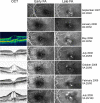Individual recurrence intervals after anti-VEGF therapy for age-related macular degeneration
- PMID: 21170547
- PMCID: PMC3084429
- DOI: 10.1007/s00417-010-1588-2
Individual recurrence intervals after anti-VEGF therapy for age-related macular degeneration
Abstract
Background: To assess the time interval to recurrent choroidal neovascular membrane (CNV) activity in eyes with neovascular age-related macular degeneration (AMD) after intravitreal anti-VEGF therapy.
Methods: Data from all patients who received intravitreal ranibizumab injections for neovascular AMD at the University of Cologne prior to February 2009 were retrospectively reviewed. Patients were treated on a pro re nata (PRN) basis and eyes with active CNV received three consecutive monthly injections. Recurrence of CNV activity was defined as recurrence of intra- or subretinal fluid on optical coherence tomography (OCT) or leakage on fluorescein angiography (FA) after initial resolution of fluid and leakage following anti-VEGF therapy. All eyes showing at least two documented recurrences of CNV activity during follow-up were included in this analysis. Recurrence intervals were calculated and were deemed to be regular or periodical if the difference between recurrence interval times was less than 50 days.
Results: Twenty-nine eyes of 28 patients met the inclusion criteria. Two to six recurrences were detected per case (mean 2.8 ± 1.1 recurrences). Recurrence intervals ranged from 41 days to 523 days (mean 5.5 ± 3.4 months, median 4.5 months). Twenty-two eyes (76%) showed at least two periodical recurrence intervals. In 12 eyes (41%), all recurrences occurred at regular intervals (2-4 recurrences, mean 2.3 ± 0.6 recurrences). Seven eyes (24%) showed irregular recurrence intervals (2-3 recurrences, mean 2.1 ± 0.4 recurrences). All 11 eyes with a classic CNV lesion component showed at least two periodical recurrence intervals. Eyes with occult CNV lesions showed periodical recurrence intervals in 11 out of 18 cases (61%).
Conclusions: Preliminary data indicate that periodical recurrences of CNV activity may be seen in eyes with neovascular AMD undergoing anti-VEGF therapy. Knowledge of individual recurrence interval times may allow for the development of an individualized treatment plan and prophylactic therapy.
Figures



References
-
- Augood C, Fletcher A, Bentham G, Chakravarthy U, de Jong PT, Rahu M, Seland J, Soubrane G, Tomazzoli L, Topouzis F, Vioque J, Young I. Methods for a population-based study of the prevalence of and risk factors for age-related maculopathy and macular degeneration in elderly European populations: the EUREYE study. Ophthalmic Epidemiol. 2004;11:117–129. doi: 10.1076/opep.11.2.117.28160. - DOI - PubMed
-
- Ferris FL, 3rd, Fine SL, Hyman L. Age-related macular degeneration and blindness due to neovascular maculopathy. Arch Ophthalmol. 1984;102:1640–1642. - PubMed
MeSH terms
Substances
LinkOut - more resources
Full Text Sources
Miscellaneous

